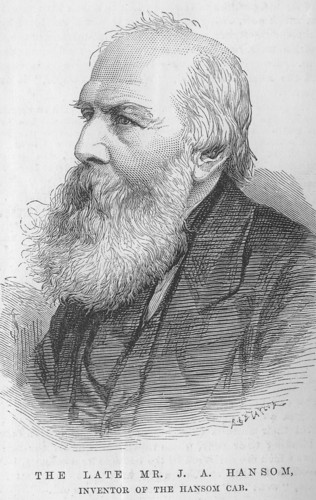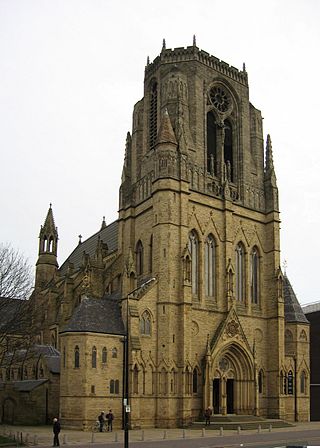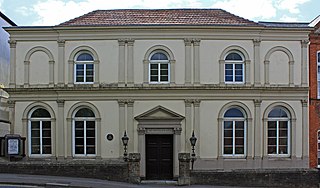The General Assembly of Unitarian and Free Christian Churches is the umbrella organisation for Unitarian, Free Christians, and other liberal religious congregations in the United Kingdom and Ireland. It was formed in 1928, with denominational roots going back to the Great Ejection of 1662. Its headquarters is Essex Hall in central London, on the site of the first avowedly Unitarian chapel in England, set up in 1774.

Melton Mowbray is a town in the Melton district in Leicestershire, England, 19 miles (31 km) north-east of Leicester, and 20 miles (32 km) south-east of Nottingham. It lies on the River Eye, known below Melton as the Wreake. The town had a population of 27,670 in 2019. The town is sometimes promoted as Britain's "Rural Capital of Food"; it is the home of the Melton Mowbray pork pie and is the location of one of six licensed makers of Stilton cheese.

Coalville is a town in the district of North West Leicestershire, Leicestershire in the East Midlands of England. In 2011, it had a population of 34,575. It lies on the A511 between Leicester and Burton upon Trent, close to junction 22 of the M1 motorway where the A511 meets the A50 between Ashby-de-la-Zouch and Leicester. It borders the upland area of Charnwood Forest to the east of the town.

Joseph Aloysius Hansom was a British architect working principally in the Gothic Revival style. He invented the Hansom cab and founded the eminent architectural journal The Builder in 1843.

Long Clawson is a village and former civil parish, now included in that of Clawson, Hose and Harby, in the Melton district and the county of Leicestershire, England. Being in the Vale of Belvoir, the village is enclosed by farmland with rich soil ideal for pasture. Milk from local farms is used for Stilton cheese, of which the Long Clawson dairy is one of the largest producers. In 1931 the civil parish had a population of 664.

The Church of the Holy Name of Jesus on Oxford Road, Manchester, England was designed by Joseph A. Hansom and built between 1869 and 1871. The tower, designed by Adrian Gilbert Scott, was erected in 1928 in memory of Fr Bernard Vaughan, SJ. The church has been Grade I listed on the National Heritage List for England since 1989, having previously been Grade II* listed since 1963.

Trinity Congregational Church, later known as Union Chapel, is a former place of worship for Congregationalists and Independent Christians in Arundel, an ancient town in the Arun district of West Sussex, England. Protestant Nonconformism has always been strong in the town, and the chapel's founding congregation emerged in the 1780s. After worshipping elsewhere in the town, they founded the present building in the 1830s and remained for many years. Former pastors included the poet George MacDonald. Robert Abraham's distinctive neo-Norman/Romanesque Revival building was converted into a market in the 1980s and has been renamed Nineveh House. The church is a Grade II Listed building.

Horsham Unitarian Church is a Unitarian chapel in Horsham in the English county of West Sussex. It was founded in 1719 to serve the large Baptist population of the ancient market town of Horsham—home of radical preacher Matthew Caffyn—and the surrounding area. The chapel's congregation moved towards Unitarian beliefs in the 19th century, but the simple brick building continued to serve worshippers drawn from a wide area of Sussex. It is one of several places of worship which continue to represent Horsham's centuries-old tradition of Protestant Nonconformism, and is the town's second oldest surviving religious building—only St Mary's, the parish church, predates it. English Heritage has listed the chapel at Grade II for its architectural and historical importance.

Bethel Baptist Chapel is a Strict Baptist place of worship in the village of Wivelsfield in East Sussex, England. The cause was founded in 1763 by members of a chapel at nearby Ditchling; Henry Booker and other worshippers seceded and began to meet at Wivelsfield after hearing a sermon by George Whitefield. Although some members of the new church soon returned to the Ditchling congregation, the cause thrived under Booker's leadership, and the present chapel—a building of "quiet and unassuming elegance" set in its own graveyard—was erected in 1780. It has served the Strict Baptist community continuously since then, and members founded other chapels elsewhere in Sussex during the 18th and 19th centuries. The chapel is a Grade II Listed building.

Ditchling Unitarian Chapel is a Unitarian chapel in Ditchling, a village in the English county of East Sussex. A congregation of General Baptists began to meet in the 17th century in the village, which was a local centre for Protestant Nonconformist worship, and by the time the present simple Vernacular-style chapel was constructed in 1740 a large proportion of the population held Baptist beliefs. Along with other General Baptist chapels in Sussex, the congregation moved towards Unitarian views in the mid-18th century; this caused a schism which resulted in a new chapel being formed at nearby Wivelsfield. The character of the Ditchling chapel was wholly Unitarian by 1800, and it has continued under various names since then. People associated with the chapel include William Hale White, Henry Acton, Adrian Boult—who was married there—and G. K. Chesterton. The chapel is set back from Ditchling's main street and has an adjoining house and graveyard, all of which contribute to the character of the conservation area which covers the centre of Ditchling village. English Heritage has listed the chapel at Grade II for its architectural and historical importance.

Taunton Unitarian Chapel is on Mary Street, Taunton, Somerset, England. It was built in the early 18th century as a Baptist chapel, but later adopted Unitarianism. The exterior was extensively renovated in the 19th century in an Italianate style. The chapel has been designated as a Grade II* listed building.

Uckfield Baptist Church is a Baptist congregation based in the town of Uckfield in East Sussex, England. Although services now take place in a school, the cause—founded in 1785 by seceders from the nearby Five Ash Down Independent Chapel—had its own chapel from 1789 until 2005, when the building closed and was sold for residential conversion. The "simple brick chapel" was rebuilt in 1874 and has been listed at Grade II for its architectural and historical importance.

Bishop Street Methodist Chapel, also known as the Wesleyan Chapel, is church overlooking Town Hall Square in Leicester, England, U.K.

The Clarendon Park Congregational Church is a Congregational church in Leicester, Leicestershire, England. It is located on London Road in the Stoneygate district near Clarendon Park.

The Central Baptist Church, also known as the Charles Street Baptist Chapel, is a Baptist church on Charles Street in Leicester, Leicestershire, England, UK. It is affiliated with the Baptist Union of Great Britain.

St Benet's Church is a Catholic church in Monkwearmouth in Sunderland. It was built in 1889 and designed by Archibald Matthias Dunn and Edward Joseph Hansom. It is located on the corner of Thomas Street North and George Street North, half a kilometre east of the Stadium of Light. From 1900 to 2011, the Redemptorists served the parish. The church is now once again served by priests from the Diocese of Hexham and Newcastle. When it was built, it was the first Catholic church in Sunderland to be built north of the River Wear in the nineteenth century.

St Mary's Church or St Mary Immaculate Church is a Roman Catholic parish church in Falmouth, Cornwall, England, United Kingdom. It was built from 1868 to 1869 and designed by Joseph Hansom. The architecture of the church, according to Historic England is a blend of "Gothic and Burgundian Romanesque styles". It is located on the corner of Kimberley Place and Killigrew Street. It was extended by Hansom's son Joseph Stanislaus Hansom in 1881 and it is a Grade II listed building.

James Tait FRIBA FRIBA was an architect based in Leicester.



















